Abstract
Background:
Diabetes burden is a serious warning for urgent action plan across the world. Knowledge production in this context could provide evidences for more efficient interventions. Aimed to that, we quantify the trend of diabetes research outputs of Middle East countries focusing on the scientific publication numbers, citations, and international collaboration.
Materials and Methods:
This scientometrics study was performed based on the systematic analysis through three international databases; ISI, PubMed, and Scopus from 1990 to 2012. International collaboration of Middle East countries and citations was analyzed based on Scopus. Diabetes’ publications in Iran specifically were assessed, and frequent used terms were mapped by VOSviewer software.
Results:
Over 23-year period, the number of diabetes publications and related citations in Middle East countries had increasing trend. The number of articles on diabetes in ISI, PubMed, and Scopus were respectively; 13,994, 11,336, and 20,707. Turkey, Israel, Iran, Saudi Arabia, and Egypt have devoted the five top competition positions. In addition, Israel, Turkey, and Iran were leading countries in citation analysis. The most collaborative country with Middle East countries was USA and within the region, the most collaborative country was Saudi Arabia. Iran in all databases stands on third position and produced 12.7% of diabetes publications within region. Regarding diabetes researches, the frequent used terms in Iranian articles were “effect,” “woman,” and “metabolic syndrome.”
Conclusion:
Ascending trend of diabetes research outputs in Middle East countries is appreciated but encouraging to strategic planning for maintaining this trend, and more collaboration between researchers is needed to regional health promotion.
Keywords: Diabetes, Middle East, scientometrics
INTRODUCTION
Improvement of science and technology considered as the essential requirement for social development all over the world. In each country, the knowledge production outputs reflect the interesting topics of researches.[1] Knowledge creation process provide the fundamental integral part of knowledge life cycle for creating, sharing, translating, and applying the generated knowledge for health promotion.[2]
Research-based Knowledge could be followed by the trends of scientometrics indicators that quantify documented research outputs in the scholarly communication framework.[3] These indicators for different fields of sciences show the scientific outputs, as a part of research activity of each country or even scientific unit. The special aim of this indicator system is characterizing and comparing the contribution of research units in the world's scientific research activities and clarifying points that need to be strengthened.[4]
Comparisons between different countries results of these metrics determine their prospects and performance of research fields. For each country; the quantity and quality of indexed articles in international databases is an important indicator of its contribution to specific field knowledge production.[5,6]
In recent decades, noncommunicable diseases (NCDs) have been intended as the most significant health problem with increasing trend, thus knowledge production in this field has been important.[7] One of the leading cause of death due to NCDs is diabetes. In the Middle East and North Africa (MENA); disabilityadjusted life year (DALY) rank's percentage change of diabetes was 87% from 1990 to 2010. In this region, diabetes was the fifth leading cause of disability while in other regions this rank varies from six to ten.[8] Ascending trend of diabetes prevalence in these countries leads to more premature heart disease and stroke that should be more emphasized through preventive health policies.[9,10,11]
Efficient preventive and health care interventions need to accurate and priority based national knowledge.[12] Comparison scientometric indicators between different countries determine their prospects and performance in this fields. Authorship as indicator of research activity and citation as indicator of reception of research are deterministic indicators that measured through international databases. In addition, collaboration measurement is an indicator of research systems’ structure at the macro level. As we know, the scientometric study was not performed in the diabetes field in MENA. Therefore, we performed the present study by considering some constant indicators. This paper aims to assess the trends of published articles and citations in the diabetes field as the proxy of these countries’ research activities during the past 23-year period and review the collaborative researches between regions’ country. In addition, we specifically focused on Iran and assessed its contribution in diabetes researches by details of scientometrics outputs of Iranian articles.
MATERIALS AND METHODS
The present study is scientometric analysis of diabetes research articles among Middle East countries from 1990 to 2012. We searched three international indexing databases with the most coverage in health and biomedicine discipline. These are ISI Web of Science (ISI/WOS), PubMed/Medline, and Scopus.[13,14,15,16]
In this study, we considered 23-year, and all databases searched for published articles related to diabetes by Middle East countries. The Middle East countries consist of Bahrain, Cyprus, Egypt, Iraq, Iran, Israel, Jordan, Kuwait, Lebanon, Oman, Palestine, Qatar, Saudi Arabia, Syria, Turkey, United Arab Emirates (UAE), and Yemen (in alphabetical order).[17] As, these databases covered same journals in some cases, all results stored in EndNote X5 software, Thomson Reuters, USA and duplicate cases was excluded.
Search strategy has designed by researchers’ committee and validated by external scientific group. Based on the controlled vocabulary of Medical Subject Heading, and Emtree, the term of “diabetes” used as a major quarry for indexing and extracting in mentioned database. Through that, we retrieved all records indexed under our predefined search strategy. Limitations were the period of papers (1990−2012), the countries that papers were submitted from (based on authors’ affiliation or address). Search strategy for each database present in Box 1
Box 1: Used search strategies in three international databases
Box 1: Search strategies
-
Search strategy in ISI Web of Science
Time span = 1990-2012. Databases=SCI-EXPANDED, SSCI, CPCI-S, CPCI-SSH.
Topic= (diabetes) AND Address= (Country's name)
-
Search strategy in PubMed/Medline
((diabetes [Title/Abstract] OR diabetes [Transliterated Title]) OR (“diabetes mellitus”[MeSH Terms])) AND Country's name [Affiliation] AND (“1990/01/01”[PDAT]: “2012/12/31”[PDAT])
-
Search strategy in Scopus
(TITLE-ABS-KEY (diabetes) AND AFFIL (Country's name)) AND PUBYEAR > 1989 AND PUBYEAR < 2013
In this way, systematic search was performed in each databases and the number of published articles related to diabetes by each country in MENA determined. Among these databases, PubMed provides the opportunity of article type analysis. Thus, the article type was investigated among those papers that were retrieved from PubMed. Citation analysis was performed based on Scopus database. As citation to published articles by Middle East countries regarding diabetes needs the time, we analyzed citation from 2000 to 2012. Also, collaboration of Middle East countries in diabetes’ knowledge production was studied based on Scopus’ results.
For estimating of P trends, the number of articles and citations imported to STATA software, version 11, StataCorp LP, USA and by Pearson Chi-square, P trends were estimated. Mann−Kendall (MK) test is a statistical test commonly used for trend analysis in time series data. The null hypothesis of this test assumes that there is no trend that is, The data is independent and randomly ordered.[18] We designed figures using R software 3.1 (the Free Software Foundation's GNU General Public License).
In the later part of this article, we specifically focus on diabetes research in Iran. We also introduce research institutions and journals that had most articles on diabetes. The information about research budget and academic members of Iran retrieved from ministry of health website.[19]
Iranian published articles were categorized according to subject area, document type, affiliation of the authors and source title. To demonstrate the indexing pattern of diabetes’ articles terms in Scopus databases, we used VOSviewer mapping software of Centre for Science and Technology Studies, Leiden University, The Netherlands.[20] We considered Scopus database because the number of diabetes articles of Iran in this database was more than the others. Using the VOSviewer and thresholds of minimally 10 fractionally counted papers for each term, a national map of diabetes articles term was generated. Each term meet the threshold, a relevance score will be calculated and based on the score, the most relevant terms were selected. For mapping Scopus diabetes articles terms, maps created based on title and abstract field.
RESULTS
Trend of diabetes publication
Through a systematic search for diabetes publication by Middle East countries, we found 14,022 article in ISI/WOS, 11366 articles in PubMed/Medline, and 20,707 articles in Scopus. The details presented in Appendix A. After deletion of duplications, the number of articles reaches 31,143. The time trend of these articles has been showed in Figure 1.
Figure 1.
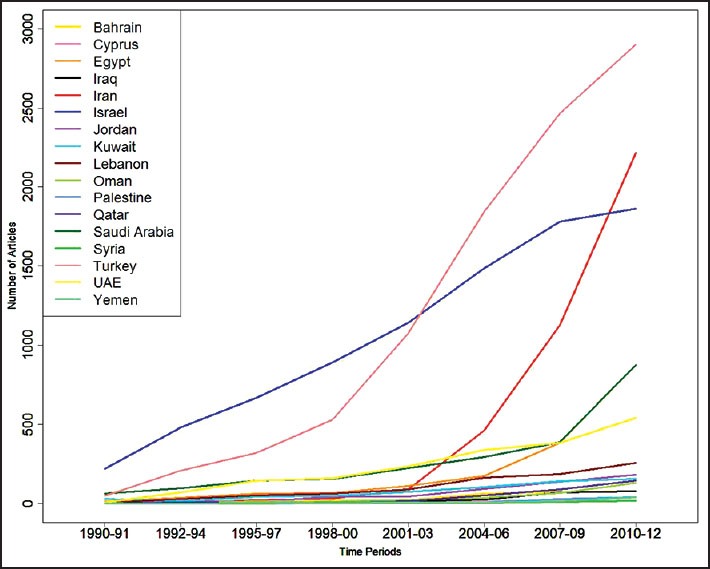
The trend of publications on diabetes in Middle East countries from 1990 to 2012
Pearson Chi-square test showed that time trends of articles in various countries are different significantly (P = 0.000). The MK test provides remarkable insight about annual publication on diabetes for Turkey, Iran and Israel. The MK correlation (rho) indicates that there is an increasing publication trend for these countries (P = 0.968, 0.936, 0.919 respectively). The correlation, however, is not strong for countries like Syria, Cyprus and Yemen (P = 0.587, 0.691, 0.701 respectively) compared to other countries. As shown in Figure 1, more than 80% of articles had been published after 2000. According to Figure 1, turkey and Iran from 2001 to 2003 have the steepest slope. From 1990 to 2012, about 70% of knowledge production on diabetes was done by three counterparts; Turkey (30.2%), Israel (27.4%), and Iran (12.7%). However, since 2011, Iran took the second place with 22.1% knowledge production in this region. As shown in Table 1, Syria (1.5%), Yemen (2.5%) and Palestine (2.8%) had the lowest contribution in diabetes knowledge production among Middle East's countries.
Table 1.
Distribution of publications on diabetes in middle east countries from 1990 to 2012
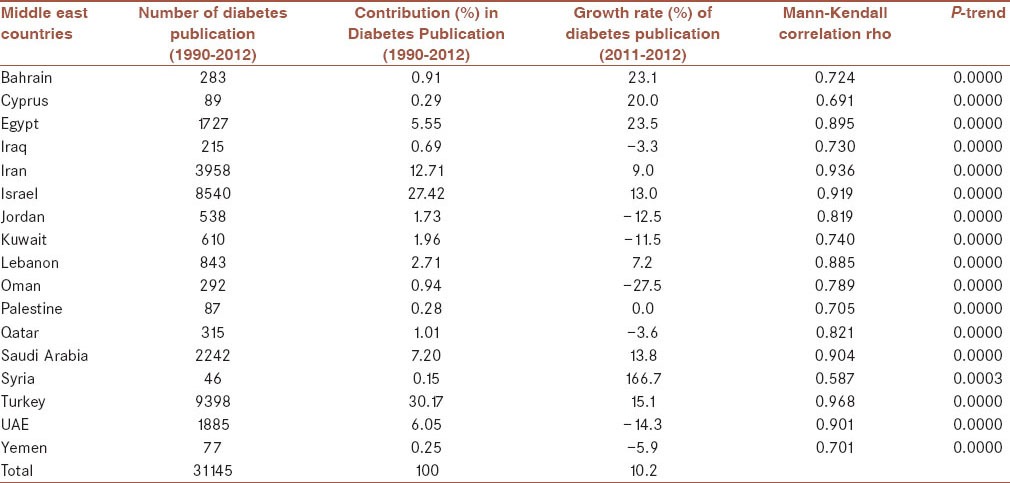
Diabetes’ articles type
Based on PubMed database, 11366 articles on diabetes in Middle East during 1990-2012 were divided to original article (72.44%; except clinical trials), review article (9.28%), clinical trial (8.71%), case report (8.03%), systematic review (1.17%), meta-analysis (0.26%), letter (0.07%), and editorial (0.04%). Along the time, type of article was varied within each country. Figure 2 shows this difference between 2000 and 2012.
Figure 2.
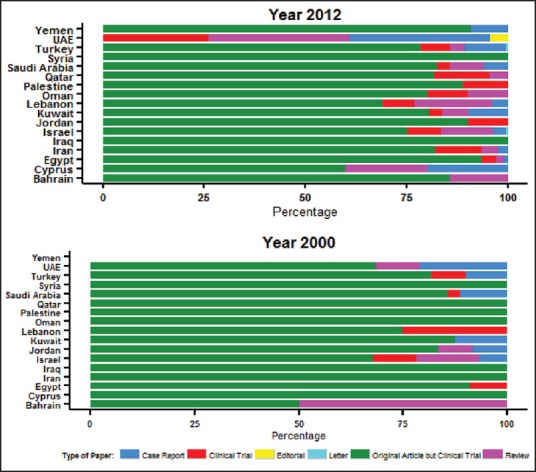
The pattern of diabetes’ article types in 2000 and 2012 based on PubMed database
International collaboration among diabetes’ articles
Based on Scopus’ results from 1990 to 2012, the most collaborative country with Middle East countries in diabetes articles is USA. As shown in Table 2, in some region's country such as Lebanon, joint articles with USA is 62.1%. Within the region, the most collaborative country is Saudi Arabia. Also, UAE collaborates with four countries in this regard.
Table 2.
International collaboration of Middle East countries in knowledge production on diabetes based on Scopus database

Citing article
Citations based on Scopus database among Israel, turkey and Iran have ascending trend. From 1990 to 2012, Syria has the less citation (349) and Israel has the most citation (191,740). Citation per paper for Israel was higher than other countries. This index in other Middle East countries are as follow; Lebanon (23), UAE (12), Cyprus (11), Kuwait and Syria (10), Jordan, Oman, Palestine and turkey (9), Egypt, Qatar, Yemen Saudi Arabia (8), and Iran, Iraq, and Bahrain (6). As citation needs time, we present trend of citation to diabetes publications of Middle East countries from 2000. The time trends of citations significantly are different among region's countries. It is shown in Figure 3.
Figure 3.
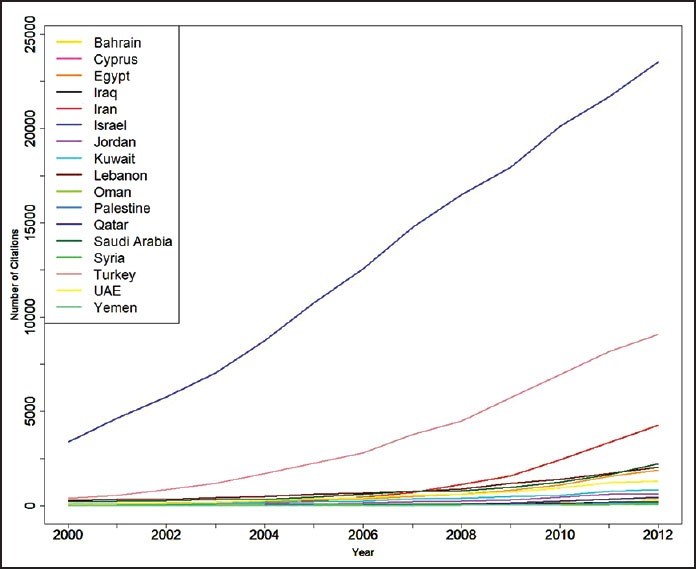
The trend of citation to diabetes articles in Middle East countries from 1990 to 2012
Diabetes publication in Iran
Iran has published 1697 article related to diabetes indexed in ISI Web of Science, 1470 article in PubMed and 3013 article in Scopus from 1990 to 2012. By excluding duplicates, 3958 article was remained.
According to ISI Web of Science database, clinical biochemistry (3.6%), diabetes research and clinical practice (3.4%), Journal of Research in Medical Sciences (3.0%), Transplantations Proceedings (1.9%), Pakistan Journal of Medical Sciences (1.8%), Archives of Iranian Medicine (1.6%), and Iranian Journal of Public Health (1.5%) were most frequent sources title in Iran. About 85.3% of Iranian articles about diabetes published in foreign journals.
Based on Scopus database, the five top rank journals for diabetes publications are Iranian Journal of Diabetes and Lipid Disorders (4.8%), Iranian Journal of Endocrinology and Metabolism (3.5%), Journal of Research in Medical Sciences (2.3%), Journal of Medicinal Plants (2.1%), and Acta Medica Iranica (1.9%) respectively.
From medical sciences universities in Iran, Tehran University of Medical Sciences had most publication on diabetes (38.1% in ISI/WOS, 30.6% in Scopus) and then Shahid Beheshti University of Medical Sciences (14.2% in ISI/WOS, 11.5% in Scopus) and Isfahan University of Medical Sciences (10.2% in ISI/WOS, 11% in Scopus) have second and third position. Assess the proportion of diabetes publications to research budget and academic members among mentioned universities in Iran show academic members, as professional resource is compatible with diabetes publication and trend of research budget is different from diabetes publications’ trend. Figure 4 shows the trend of three top rank universities of Iran in diabetes publication adjusted to Research budget and Academic member in recent years.
Figure 4.
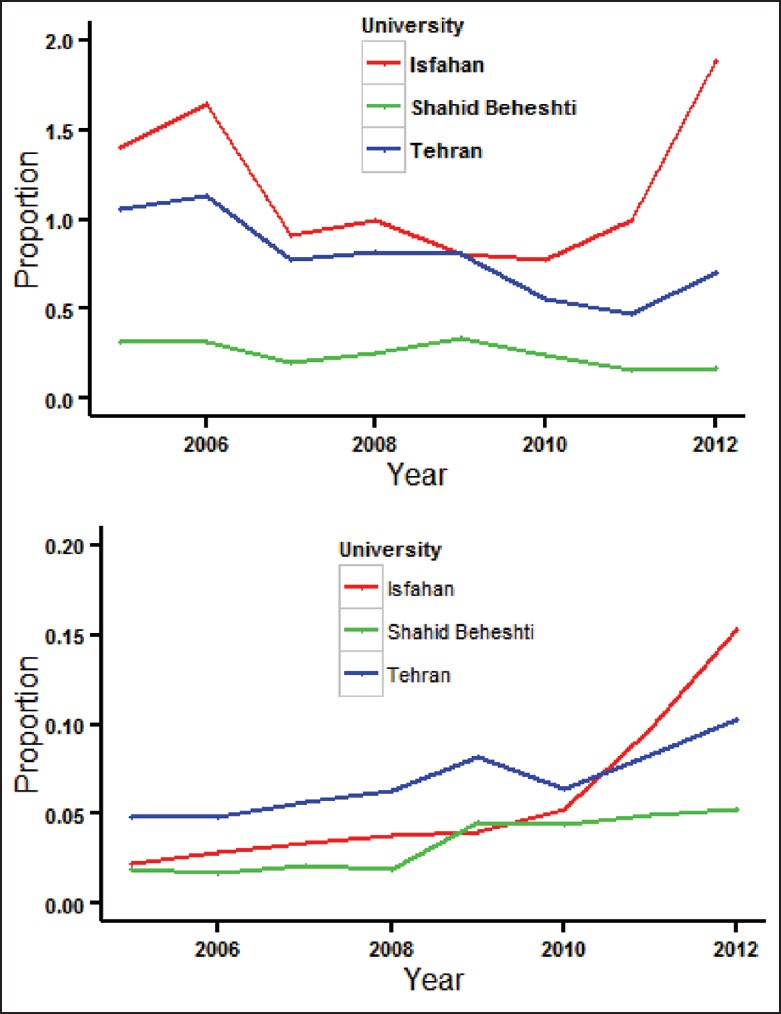
The trend of three top rank universities of Iran in diabetes publication adjusted to research budget (a) and academic member (b)
In mapping the Scopus terms frequency network, from the 9922 terms, 412 terms meet the threshold. Then 247 terms selected as relevant terms based on calculated relevance score. Figure 5 shows the label view with connection lines.
Figure 5.
Map of frequent terms in Iranian diabetes articles indexed in Scopus
Figure 5 demonstrates the network of frequently used terms in diabetes-related Iranian articles. Colored regions show subject areas of researches. The font size is an indication of terms frequency. For example, “metabolic syndrome” term has more publicized than “diet” term. Some common terms between the borders of the major region refer to common research fields. In addition, the size of bubbles and related terms font reflects terms frequency. Based on the map the terms of “woman” and “effect” had most frequency. It is noticeable that less frequent terms, for example coronary artery, have inconspicuous view.
DISCUSSION
The burden of diabetes has increased dramatically through two past decades.[8] Many countries attend to diabetes researches because, priority based researches could produce scientific evidence for addressing health threatening problems such as diabetes.[21,22,23]
In Middle East, Turkey, Israel, and Iran have considerable ascending trends of diabetes publication. In Turkey and Iran, size of the population and consequently the size of professional researchers, and developing specialized research centers are effective factors in this progress.[24] Israel has lower population size but strongly collaborate with international researchers so that about half of their publications on diabetes are in collaborating with USA.
As shown in Table 3, despite appropriate human and financial resources, some countries have been shown less interest in diabetes publications.[25,26] In some cases such as Bahrain and Oman diabetes’ DALY is noteworthy alarming but their publication in this regards is low. Similarly, this mismatch between the burden of disease and knowledge production is seem in India and China.[27] Health relies on valid, reliable, and accessible knowledge thus attention of policy makers on proper resource allocation could provide the appropriate context for research, knowledge production and consequently healthy situation.
Table 3.
Comparison resources, diabetes’ DALY, and publications on diabetes among middle east countries

In this regards, maintain ascending trend of publication needs more attention. A bibliometric study on diabetes literature from 1995 to 2005 revealed doubling time of diabetes publication increase every year.[28] As shown in Table 1, increase growth rate in countries with more publication is more difficult than others.
Pattern of article types in 2000 and 2012 shows attention to clinical trials that have been increased during the time of the study. Also review articles, which have the essential role in citation increase, have increased in Middle East countries.
International collaboration of researchers opens a window to promote knowledge exchange.[29] Joint project, as the essential factor of this more effective scientific collaboration should be more attention and effort.[30,31] Similarities such as regional conditions, lifestyle, and common health problems could intend Middle East countries to emerging a regional network to benefit from shared potential and investments.[32]
Citation could be one of the representative indexes of paper's quality. In some country such as Iran, trend of citation has ascending pattern but the index of citation per paper needs more attention. diabetes care, diabetes, diabetic medicine, diabetologia, and diabetes research and clinical practice are five top ranks of journals in diabetes research.[28] Only 3.4% of ISI indexed articles on diabetes in Iran published in diabetes research and clinical practice journal. Joint projects with developed countries could help to more efficient knowledge production.[33]
In Iran, presence endocrinology and metabolism diseases research centers in Tehran, Shahid Beheshti and Isfahan Medical Science Universities and the role of their researchers are some of the main potentials in Iran.
Assess the frequent terms used in Iranian articles about diabetes revealed that the terms of “effect,” “woman” are frequent terms in Scopus database. It seems “effect” is used in biomedical articles, but frequently used of “woman” may be signed of researcher attention to more prevalence of diabetes in Iranian women. It is noticeable; heart disease despite its importance in this area was not considered.[33]
Our study has some strength points. First, we focused on one subject of endocrinology domain to clarify the situation of knowledge production about diabetes as growing and threatening factor. Second, we use three international databases with the most coverage. Third, we assess collaboration between Middle East countries in this area based on the international database and fourth, we explain the situation of Iran as a knowledge productive country in the region in details.
Of course, in our study, we faced with some limitation such as; presence multidisciplinary subject category and overlap between databases categories that considered in scientometric analysis.
CONCLUSION
This study provides a scientometrics analysis about diabetes research in Middle East region and collaboration analysis among this region's countries. Ascending trend of diabetes research outputs in this region is appreciated but encouraging to strategic planning for maintaining this trend, and more collaboration between researchers is needed to regional health promotion. We suggest regional diabetes network[34] and we hope making confident evidence in this regards.
AUTHOR'S CONTRIBUTION
NP, ShDj, AK, FF and BL contributed in the conception of the work, conducting the study, revising the draft, approval of the final version of the manuscript, and agreed for all aspects of the work. ShN and TH had contribution in the general designing of paper, and revision. All authors have given approval to the final version of the manuscript.
ACKNOWLEDGMENTS
We would like to express thanks to Deputy Minister of Research and Technology of MOH and Setad-e-Ejraie Farmane Imam. This article is related to Ph.D. students’ thesis.
APPENDIX A

Footnotes
Source of Support: Nil
Conflict of Interest: None declared.
REFERENCES
- 1.Gray M, Schubert L. Sustainable social work: Modelling knowledge production, transfer, and evidence-based practice. Int J Soc Welfare. 2012;21:203–14. [Google Scholar]
- 2.von Krogh G, Nonaka I, Rechsteiner L. Leadership in organizational knowledge creation: A review and framework. J Manage Stud. 2012;49:240–77. [Google Scholar]
- 3.Djalalinia SH, Owlia P, Forouzan AS, Habibi E, Dejman M, Eftekhari MB, et al. Health research evaluation and its role on knowledge production. Iran J Public Health. 2012;41:39–46. [PMC free article] [PubMed] [Google Scholar]
- 4.Serenko A, Bontis N, Booker L, Sadeddin K, Hardie T. A scientometric analysis of knowledge management and intellectual capital academic literature (1994-2008) J Knowl Manage. 2010;14:3–23. [Google Scholar]
- 5.Adams J, King Ch, Pendlebury D, Hook D, Wilsdon J. Research Report Middle East Exploring The Changing Landscape of Arabian, Persian and Turkish Research: Thomson Reuters. 2011. [Last accessed on 2014 Apr 25]. Available from: http://www.tumj.ir/pdf/globalresearchreport.pdf .
- 6.McKee M, Stuckler D, Basu S. Where there is no health research: What can be done to fill the global gaps in health research? PLoS Med. 2012;9:e1001209. doi: 10.1371/journal.pmed.1001209. [DOI] [PMC free article] [PubMed] [Google Scholar]
- 7.Beaglehole R, Bonita R, Horton R, Adams C, Alleyne G, Asaria P, et al. Priority actions for the non-communicable disease crisis. Lancet. 2011;377:1438–47. doi: 10.1016/S0140-6736(11)60393-0. [DOI] [PubMed] [Google Scholar]
- 8.Seattle, WA: IHME; 2013. [Last accessed on 2014 Apr 24]. Institute for Health Metrics and Evaluation, Human Development Network, The World Bank. The Global Burden of Disease: Generating Evidence, Guiding Policy Middle East and North Africa Regional Edition. Available from: http://www.healthmetricsandevaluation.org/gbd/publications/policy-report/global-burden-disease-middle-east-north-africa . [Google Scholar]
- 9.Danaei G, Finucane MM, Lu Y, Singh GM, Cowan MJ, Paciorek CJ, et al. National, regional, and global trends in fasting plasma glucose and diabetes prevalence since 1980: Systematic analysis of health examination surveys and epidemiological studies with 370 country-years and 2·7 million participants. Lancet. 2011;378:31–40. doi: 10.1016/S0140-6736(11)60679-X. [DOI] [PubMed] [Google Scholar]
- 10.The Global Burden. International Diabetes Federation. 2012. [Last accessed on 2014 Apr 24]. Available from: http://www.idf.org/diabetesatlas/5e .
- 11.Danaei G, Singh GM, Paciorek CJ, Lin JK, Cowan MJ, Finucane MM, et al. The global cardiovascular risk transition: Associations of four metabolic risk factors with national income, urbanization, and Western diet in 1980 and 2008. Circulation. 2013;127:1493–502. doi: 10.1161/CIRCULATIONAHA.113.001470. 15021. [DOI] [PMC free article] [PubMed] [Google Scholar]
- 12.Jones AC, Geneau R. Assessing research activity on priority interventions for non-communicable disease prevention in low- and middle-income countries: A bibliometric analysis. Glob Health Action. 2012;5:1–13. doi: 10.3402/gha.v5i0.18847. [DOI] [PMC free article] [PubMed] [Google Scholar]
- 13.Web of Science. [Last accessed on 2014 Apr 24]. Available from: http://www.thomsonreuters.com/products_services/science/science_products/a-z/web_of_science/
- 14.Masic I. Review of Most Important Biomedical Databases for Searching of Biomedical Scientific Literature. Donald Sch J Ultrasound Obstet Gynecol. 2012;6:343–61. [Google Scholar]
- 15.Scopus. [Last accessed on 2014 Apr 24]. Available from: http://www.scopus.com .
- 16.PubMed. [Last accessed on 2014 Apr 24]. Available from: http://www.ncbi.nlm.nih.gov/pubmed/
- 17.List of Middle East Countries by Population. [Last accessed on 2014 Apr 24]. Available from: http://www.worldatlas.com/webimage/countrys/asia/lgcolor/middleeastmap.htm .
- 18.Onoz B, Bayazit M. The Power of Statistical Tests for Trend Detection. Turk J Eng Environ Sci. 2003;27:247–51. [Google Scholar]
- 19.Health Research System of Iran. [Last accessed on 2014 Jan 24]. Available from: http://www.hbi.ir/NSite/SpecialFullStory/News/?Id=779&Level=9 .
- 20.VOSviewer Version 1.5.4. [Last accessed on 2014 Mar 24]. Available from: http://www.vosviewer.com/download/
- 21.Imani-Nasab MH, Seyedin H, Majdzadeh R, Yazdizadeh B, Salehi M. Development of evidence-based health policy documents in developing countries: A case of Iran. Glob J Health Sci. 2014;6:27–36. doi: 10.5539/gjhs.v6n3p27. [DOI] [PMC free article] [PubMed] [Google Scholar]
- 22.Peykari N, Djalalinia S, Owlia P, Habibi E, Falahat K, Ghanei M, et al. Health research system evaluation in I.R. of Iran. Arch Iran Med. 2012;15:394–9. [PubMed] [Google Scholar]
- 23.Compare Contries and Regions. [Last accessed on 2014 Jan 24]. http://www.scimagojr.com/compare.php?c1=IR&c2=TR&c3=IL&c4=&area=2700&category=2712&in=it .
- 24.Harande Y. Exploring the literature of diabetes in Nigeria: A bibliometrics study. Afr Diabetes Med. 2011;19:8–11. [Google Scholar]
- 25.GDP per Capita Reported by World Bank in. [Last accessed on 2014 Apr 25];2011 2 Available from: http://www.data.worldbank.org/indicator . [Google Scholar]
- 26.Diabetes’ DALYs per 100,000 Estimated by Institute of Health Metrics and Evaluation in 2010. [Last accessed on 2014 Apr 25]. Available from: http://www.viz.healthmetricsandevaluation.org/gbd-compare/
- 27.Arunachalam S, Gunasekaran S. Diabetes research in India and China Today: From Literature-based mapping to health-care policy. Curr Sci. 2002;82:1086–97. [Google Scholar]
- 28.Krishnamoorthy G, Ramakrishnan J, Devi S. Bibliometric analysis of literature on diabetes (1995-2004) Ann Libr Inf Stud. 2009;56:150–5. [Google Scholar]
- 29.Ernst D, Kim L. Global production networks, knowledge diffusion, and local capability formation. Res Policy. 2002;31:1417–29. [Google Scholar]
- 30.Alenzi FQ, Lotfy M, Nasif W, El-Shahat M, Abusini H, Alenazi M, et al. Biomedical research in the Middle Eastern countries: Update and insight using SCImago Journal Rank indicator. J Ayub Med Coll Abbottabad. 2010;22:100–5. [PubMed] [Google Scholar]
- 31.Lagendijk A, Cornford J. Regional institutions and knowledge-Tracking new forms of regional development policy. Geoforum. 2000;31:209–18. [Google Scholar]
- 32.Baskerville R, Dulipovici A. The theoretical foundations of knowledge management. Knowl Manage Res Pract. 2006;4:83–105. [Google Scholar]
- 33.Balakrishnan MS. Methods to increase research output: Some tips looking at the MENA region. Int J Emerg Mark. 2013;8:215–39. [Google Scholar]
- 34.Keshtkar A, Djalalinia Sh, Khashayar P, Peykari N, Mohammdi Z, Larijani B. Iranian Health Research Networks and Vision of Iran by 2025: A case of virtual health network in EMRI. Iran J Public Health. 2013;42:78–83. [PMC free article] [PubMed] [Google Scholar]



